
Coalbrook
Coalbrook, or now called Holly Country, was a coal mining village. Situated just south of Sasolburg. It is well known because of the Coalbrook disaster, a mining accident during which 435 miners lost their lives. GPS coordinates: 26.9364S 27.9157E elevation: 1477m
I actually wanted to write about the little village of Holly Country. But that place is hardly known, but what is well known is Coalbrook. That was a coal mine in the area where the major disaster happened in 1960. Thus I thought lets use the name Coalbrook to get some hits to this website. I also have to mention here that the previous name for the little village is Clydesdale.
Reading through some reports there is now more clarity on the names. The Coalbrook mine was part of the Clydesdale Colliery company. Thus the name of the village as Clydesdale.
History
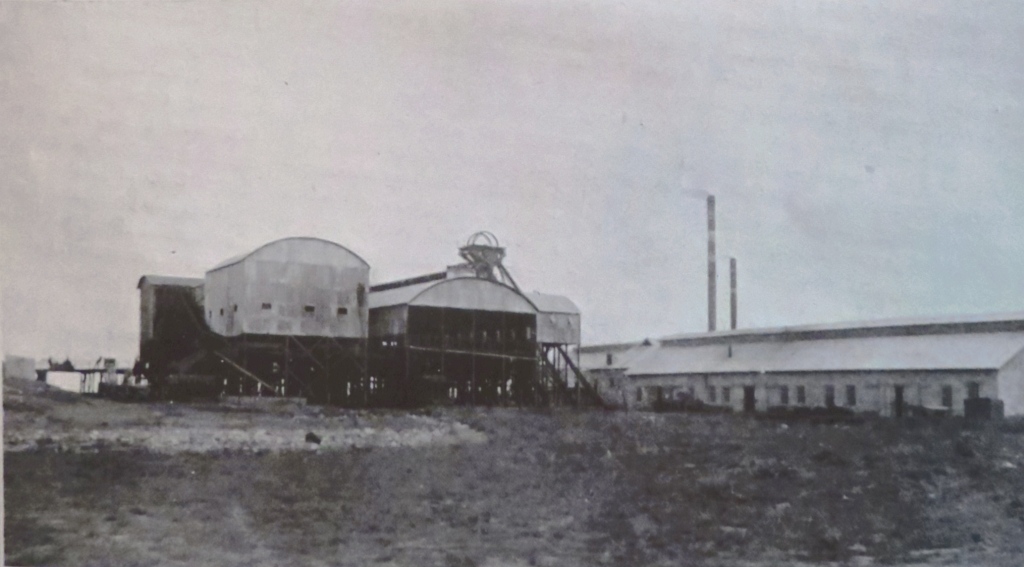 Coalbrook mine goes back a long way, the first shaft was sunk in 1904. In those early days it was driven by electricity, provided by five Babcock & Wilcox boilers each producing 110 hp (horse power). This is why we see two chimneys in the picture. It had a rail connection to the Coalbrook Station, now just south of Sasolburg. Some of the old rails are still visible in the road crossings. More of the early history of the mine is described in the hyperlink Lessons From Coalbrook. But because the article mainly deals with the disaster and the history leading up to the disaster, it mostly deals with reduction of the size of the pillars and also something called 'topcoaling'. That meant increasing the height to get at the coal further up the seam. Initially at the limited scale because the quality of coal extracted from the top was not that good. This changed when the newly erected power station 'Taaibos' in 1954 required an increase in extraction from the mine and the boilers had been designed such that they could accept lower quality coal. Output from the mine had to increase from roughly 500 000 to 2.8 Million per annum.
Coalbrook mine goes back a long way, the first shaft was sunk in 1904. In those early days it was driven by electricity, provided by five Babcock & Wilcox boilers each producing 110 hp (horse power). This is why we see two chimneys in the picture. It had a rail connection to the Coalbrook Station, now just south of Sasolburg. Some of the old rails are still visible in the road crossings. More of the early history of the mine is described in the hyperlink Lessons From Coalbrook. But because the article mainly deals with the disaster and the history leading up to the disaster, it mostly deals with reduction of the size of the pillars and also something called 'topcoaling'. That meant increasing the height to get at the coal further up the seam. Initially at the limited scale because the quality of coal extracted from the top was not that good. This changed when the newly erected power station 'Taaibos' in 1954 required an increase in extraction from the mine and the boilers had been designed such that they could accept lower quality coal. Output from the mine had to increase from roughly 500 000 to 2.8 Million per annum.
Following the disaster extraction from the Coalbrook north mine (as it was called in one of the reports) was halted for a while but was than started again in the non-affected sections. After another shift in the strata in March 1961 the mine was finally abandoned.
The Disaster
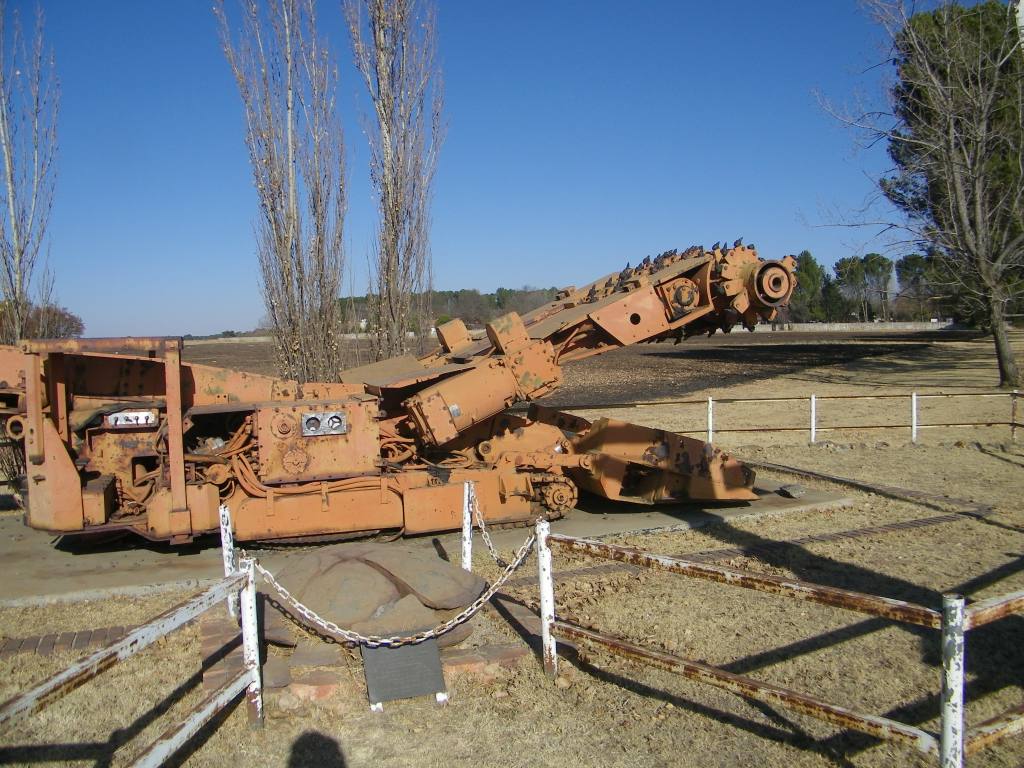
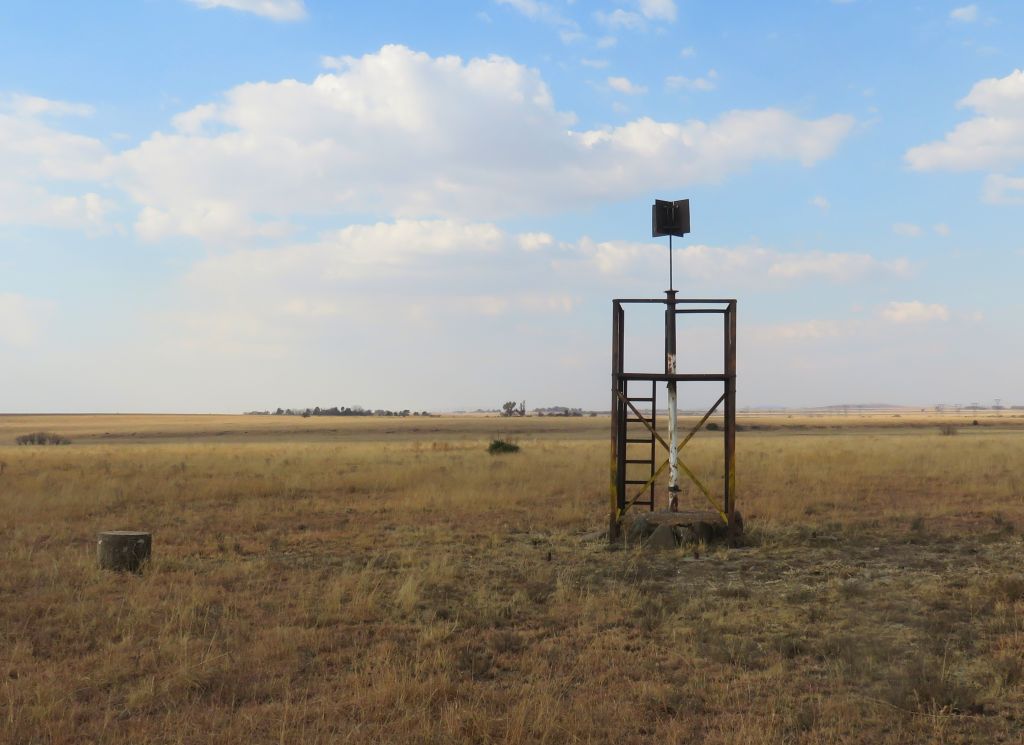 On the 21th of January of 1960 at just after 19h00 there was a massive collapse of the mine trapping 435 miners forever under the ground. Frantic efforts to reach them were made with no success, access, at least, to the section where they were working had totally collapsed. It is believed that about 900 pillars collapsed. Methane was detected in the mine thus hampering rescue efforts from the level below. A hole was drilled from the surface through 140m of soil and rock. The picture shows the top end of this hole as it looks today. A microphone lowered only picked up the sound of water and nothing else. All hope of finding survivors was thus dashed. Work on the rescue shaft was halted.
On the 21th of January of 1960 at just after 19h00 there was a massive collapse of the mine trapping 435 miners forever under the ground. Frantic efforts to reach them were made with no success, access, at least, to the section where they were working had totally collapsed. It is believed that about 900 pillars collapsed. Methane was detected in the mine thus hampering rescue efforts from the level below. A hole was drilled from the surface through 140m of soil and rock. The picture shows the top end of this hole as it looks today. A microphone lowered only picked up the sound of water and nothing else. All hope of finding survivors was thus dashed. Work on the rescue shaft was halted.
A good summary of the events can be found on Times Live and the more technical background at Lessons From Coalbrook
A memorial has been erected using one of the old mining machines in Clydesdale. The plague states:
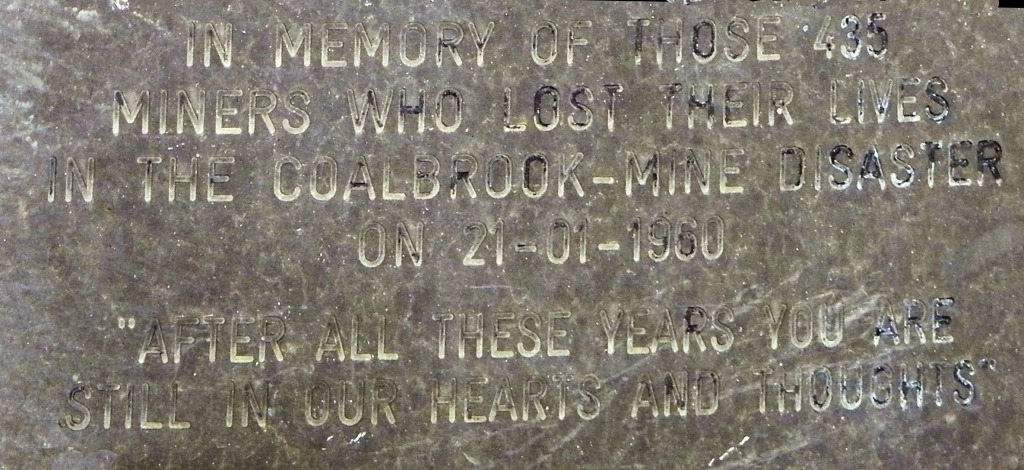 IN MEMORY OF THOSE 435
IN MEMORY OF THOSE 435
MINERS WHO LOST THEIR LIVES
IN THE COALBROOK-MINE DISASTER
ON 21-1-1960
AFTER ALL THOSE YEARS YOU ARE
STILL IN OUR HEARTS AND THOUGHTS
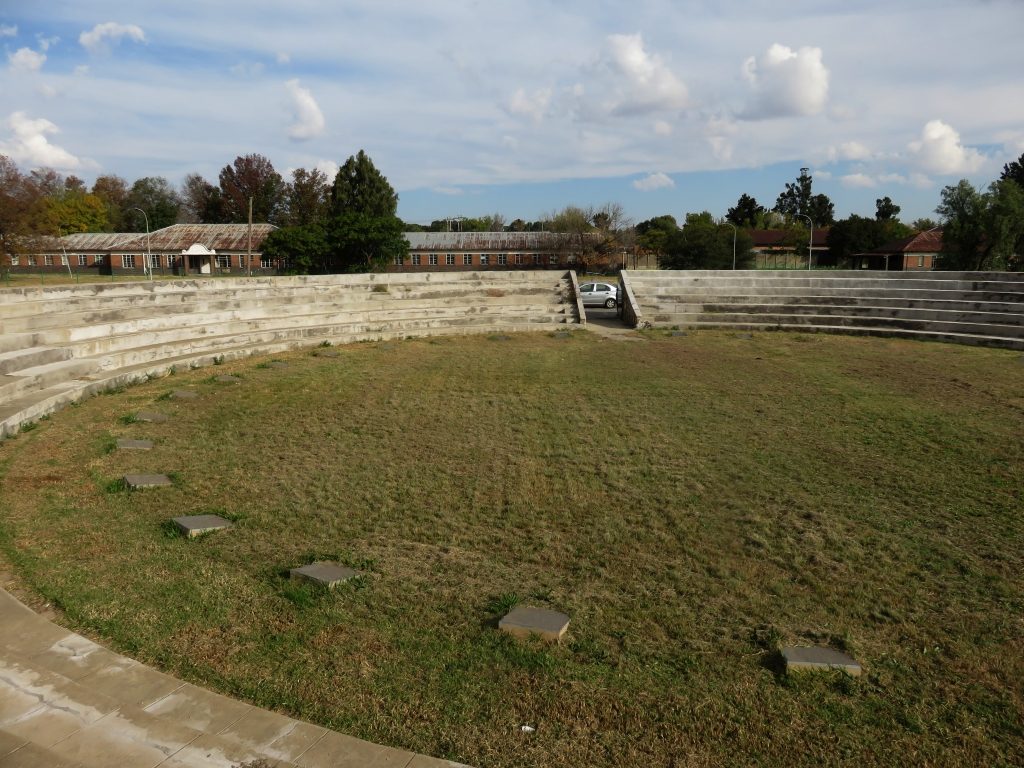
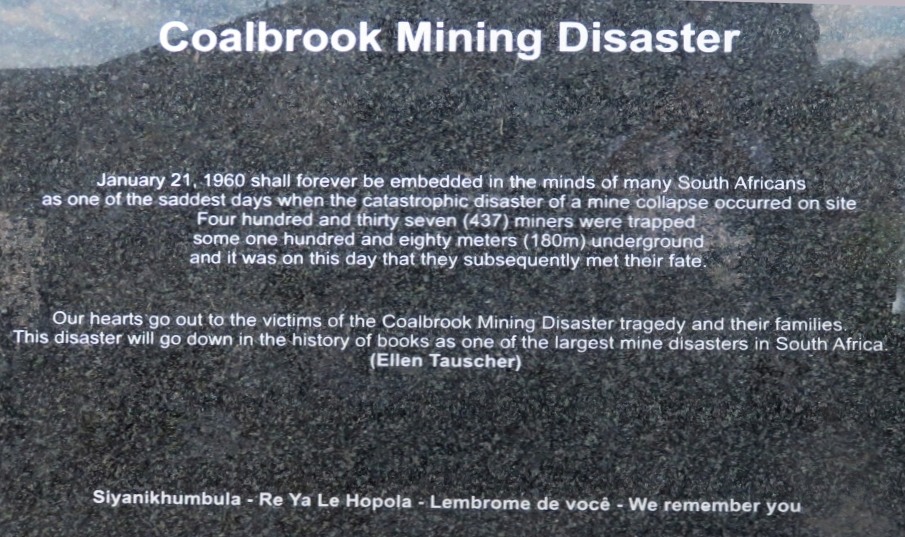 There is also a newer and far larger monument. It is in the form of an amphitheatre, situated where the South shaft used to be. All 437 names are engraved on stones placed around the inside perimeter and two stone tablets at the entrance commemorating the event. A criticism I have is the Ellen Tauscher quote on the stone: 'Our hearts go out to the victims of the coalbrook mining disaster tragedy and their families. This disaster will go down in the history of books as one of the largest mine disasters in South Africa. (Ellen Tauscher)'.
Ellen Tauscher an American politician said the following after Hurricane Katrina struck the American Midwest in 2005: 'My heart goes out to victims and survivors of the Hurricane Katrina tragedy and to their families. This disaster will go down in history books as one of the largest natural disasters in U.S. History.'
There is also a newer and far larger monument. It is in the form of an amphitheatre, situated where the South shaft used to be. All 437 names are engraved on stones placed around the inside perimeter and two stone tablets at the entrance commemorating the event. A criticism I have is the Ellen Tauscher quote on the stone: 'Our hearts go out to the victims of the coalbrook mining disaster tragedy and their families. This disaster will go down in the history of books as one of the largest mine disasters in South Africa. (Ellen Tauscher)'.
Ellen Tauscher an American politician said the following after Hurricane Katrina struck the American Midwest in 2005: 'My heart goes out to victims and survivors of the Hurricane Katrina tragedy and to their families. This disaster will go down in history books as one of the largest natural disasters in U.S. History.'
I also have a problem with the falsified quote which said: 'one of the largest mine disasters in South Africa', it should be 'the largest mine disaster'. I could nitpick a bit more, but will leave it at that.
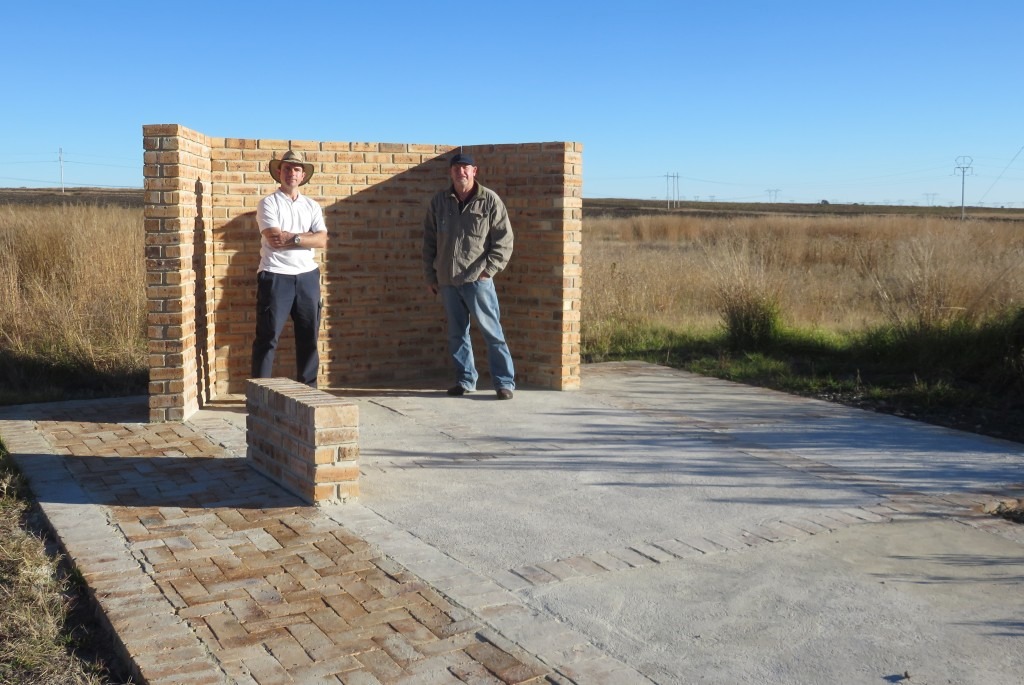 Another monument has been partially constructed at the site of the East Shaft, next to the R57, the road between Sasolburg and Heilbron. It is next to the road (west) of the Sasolburg Heilbron road and not far from the rescue shaft. That is probably the reason why the memorial was going to be erected here. A pathway has been laid and some walls constructed, but otherwise nothing further has been done. Missing are the inscriptions of what this monument is all about.
Another monument has been partially constructed at the site of the East Shaft, next to the R57, the road between Sasolburg and Heilbron. It is next to the road (west) of the Sasolburg Heilbron road and not far from the rescue shaft. That is probably the reason why the memorial was going to be erected here. A pathway has been laid and some walls constructed, but otherwise nothing further has been done. Missing are the inscriptions of what this monument is all about.
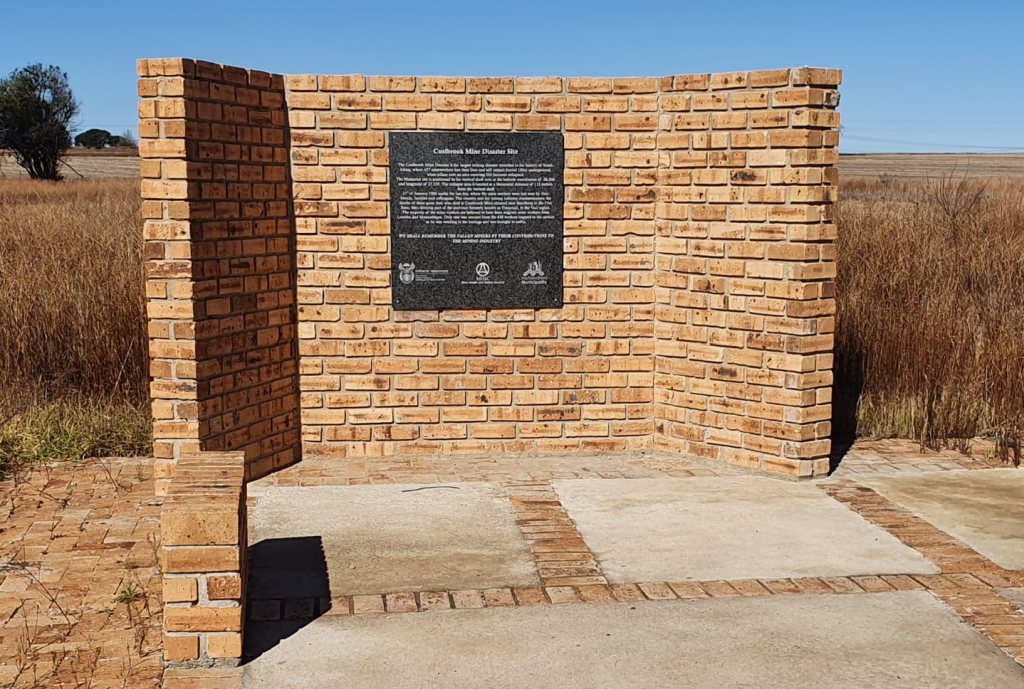 Before the plaque could be installed a strong storm collapsed the wall. It was re-built and now the memorial plaque was installed. This must have been early in 2021. What follows is the text as inscribed, note the semi-colon indicates a line break:
Before the plaque could be installed a strong storm collapsed the wall. It was re-built and now the memorial plaque was installed. This must have been early in 2021. What follows is the text as inscribed, note the semi-colon indicates a line break:
Coalbrook Mine Disaster Site; The Coalbrook Mine Disaster is the largest mining disaster recorded in the history of South; Africa, where 437 mineworkers lost their lives and still remain buried 180 m underground,; when pillars over an area covering 325 hectares collapsed.; The Memorial site is positioned in the vertical shaft area at the latitude coordinates of -26.546; and longitude of 27.559. The collapse area is located at a horizontal distance of 115 meters; from the vertical shaft.; 21th of January 1960 marks the last day, where the mineworkers were last seen by their; friends, families and colleagues. The country and the mining industry commemorates the; death of these great men who died at Coalbrook Mine situated near Sasolburg in the Free; State, then forming part of the province formerly known as Transvaal, in the Vaal region.; The majority of the mine workers are believed to have been migrant mine workers from; Lesotho and Mozambique. Only one was rescued from the 438 workers trapped in the section; as he was working in the haulage and was brought to safety.; WE SHALL REMEMBER THE FALLEN MINERS BY THEIR CONTRIBUTIONS TO THE MINING INDUSTRY
There are two inexcusable mistakes in this text. The Free State is not and was never part of the Transvaal. At the time of the disaster they were two provinces of South Africa. The other problem are the coordinates, putting them into GoogleEarth I get to a point 55 kilometres to the north west from here. Thus those coordinates are obviously wrong.
A fuller description of the disaster is available through an article in the Heritage Portal written by me, click here.
Clydesdale/Holly Country
 Clydesdale is the name shown on my topographic map. The name was changed to Holly Country in 1996. Regarding the name we also have to note that Wikipedia refers to the village as Coalbrook Mining Village, thus the confusion regarding the names increases. When the village was established is not known, at least not to me. Judging by the style of the houses most likely in the 50th, and that would make sense since coal production increased dramatically in 1954 to feed the new Taaibos Powerstation near by.
Clydesdale is the name shown on my topographic map. The name was changed to Holly Country in 1996. Regarding the name we also have to note that Wikipedia refers to the village as Coalbrook Mining Village, thus the confusion regarding the names increases. When the village was established is not known, at least not to me. Judging by the style of the houses most likely in the 50th, and that would make sense since coal production increased dramatically in 1954 to feed the new Taaibos Powerstation near by.
The Taaibos and Highveld power station was shut down around 1990, this also put an end to coal mining in the area. Thus there was a village without a mine. The saviour in this case was Mr.Richard Hse, a Taiwanese businessman, who bought the village in October 1996. He renamed it to Holly Country. The workshops 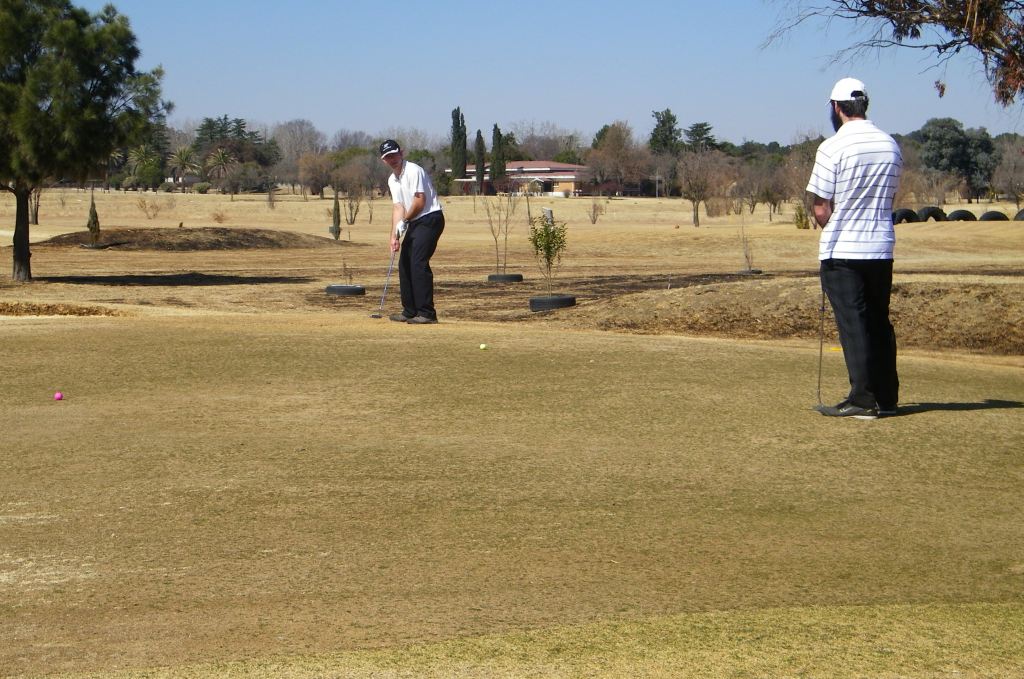 and colliery he has turned into a hub of factories and the houses of the village are for rent. He tried to sell them off individually but somehow this could not be done, it requires subdivision of the property and that turned out to be impossible on some legal grounds. Since then all the houses are rented out, and I belief at very reasonable rates.
and colliery he has turned into a hub of factories and the houses of the village are for rent. He tried to sell them off individually but somehow this could not be done, it requires subdivision of the property and that turned out to be impossible on some legal grounds. Since then all the houses are rented out, and I belief at very reasonable rates.
All mining villages in these days had a recreation club, Clydesdale was no exception. It had a hall, a bar, a swimming pool, bowling greens, tennis courts and what is most important a golf course. Most of these are not usable but much to the credit of Mr.Hse and his wife Mamachan the golf course was re-established and is still going. I have been playing there on numerous occasions.
Taaibosspruit village
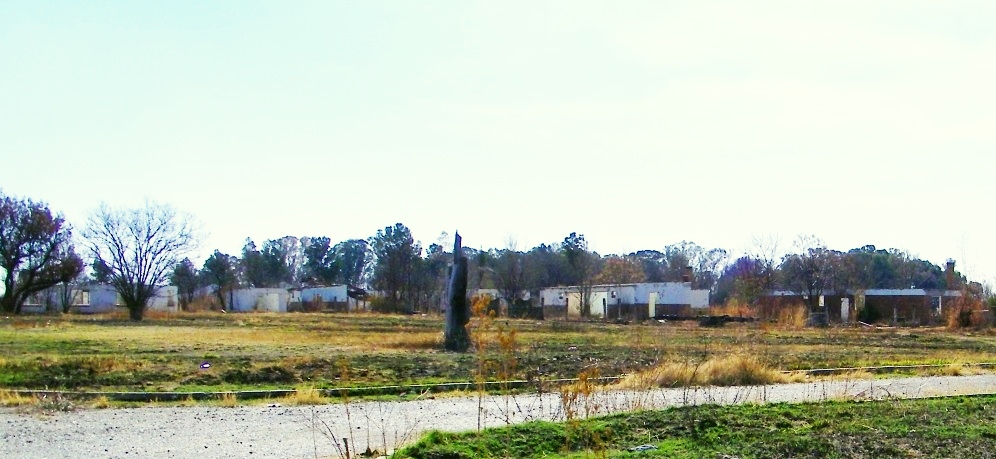 As one turns into the road leading down to Holly Country, on the right used to be a small village. The shells of the houses are still standing. Apparently this was the village for the white staff of Coalbrook north mine.
As one turns into the road leading down to Holly Country, on the right used to be a small village. The shells of the houses are still standing. Apparently this was the village for the white staff of Coalbrook north mine.
This brings me to the question of the original village, which must have existed when the mine started in 1905. Being far away from the centres, 40km to Vereeniging and 45km to Heilbron (Sasolburg and Vanderbijlpark didn't exist in those days), made it a necessity to provide accommodation. And I found them on Google Earth, just on the other side of the road across from Taaibosspruit one can see the foundations of the houses that did exist than.
Taaiboschspruit school
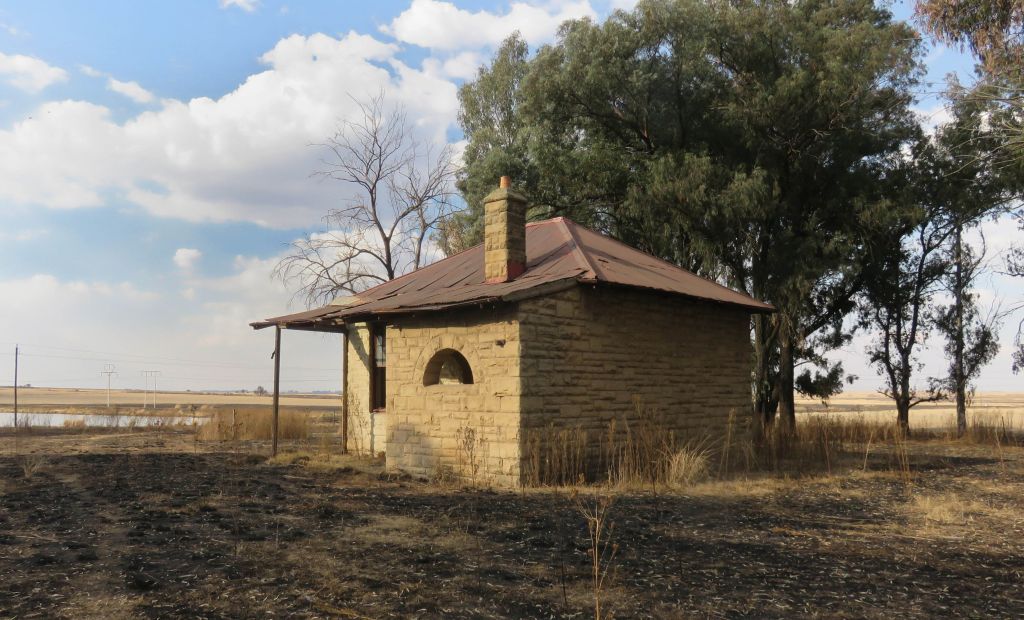 In the early nineteen hundreds there was a move to take education out into the rural areas and a number of small elementary schools were constructed to cater for the children of the farming areas. The so called 'plaas skoole' were most of the time single class room with one teacher teaching all grades. Taaiboschspruit was one of them. When exactly the school was built is not known.
In the early nineteen hundreds there was a move to take education out into the rural areas and a number of small elementary schools were constructed to cater for the children of the farming areas. The so called 'plaas skoole' were most of the time single class room with one teacher teaching all grades. Taaiboschspruit was one of them. When exactly the school was built is not known.
Reference:
Rev 1.: Standard Encyclopedia of Southern Africa, Nasou Limited, 1974
Rev 2.: 'The Orange Free State - its pastoral, agricultural and industrial resources', compiled by Somerset Playne, printed by the foreign and colonial, compiling and publishing company, 1912
There are number of internet references dealing with the subject, some of the most informative are listed below:
Lessons from Coalbrook
by J.N. van der Merwe, published in The Journal of The Southern African Institute of Mining and Metallurgy
A blog on the Coalbrook mine disaster by Berend Schuitema.